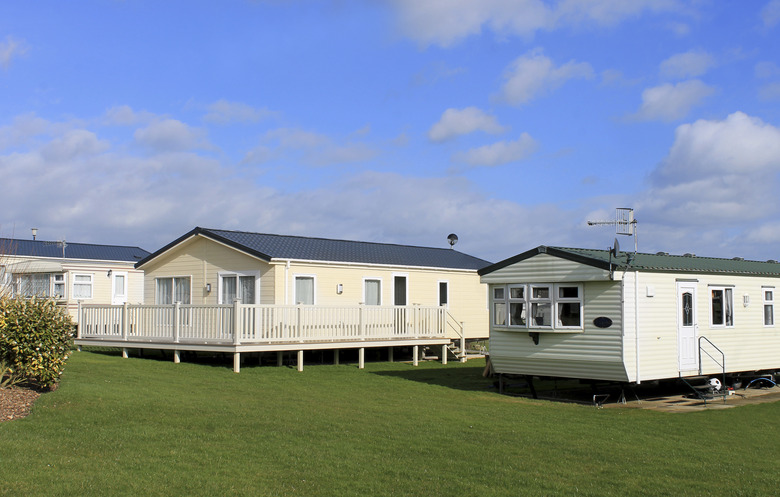How To Install Insulation Under A Mobile Home
Things Needed
-
6 mil plastic sheeting
-
Flat-head screwdriver
-
Phillips screwdriver
-
Pry bar
-
Pipe insulation
-
Silicone caulk
-
Fiberglass batt insulation
-
Staple gun
-
Polyurethane foam insulation
Because the underbelly of a mobile home is open to the elements, properly insulating it dramatically improves conditions inside the home. The manufacturer can do this more easily in the factory than you can onsite, because once the home is set up, space underneath it is limited. Most mobile homes have a fiberboard or fabric road barrier to protect the underbelly while the unit is in transit. You must remove this barrier before insulating and reinstall it afterwards. If it's significantly damaged, you may want to consider replacing it, because it protects the insulation from critters.
Step 1
Lay a moisture barrier on the ground underneath the mobile home before you begin insulating. A suitable barrier would be 6 mil polyethylene plastic sheeting. The moisture barrier prevents ground moisture from infiltrating the insulation, and it's also more comfortable to crawl on than bare ground.
Step 2
Pry off the road barrier beneath the mobile home using a flat-head screwdriver to remove staples, a Phillips screwdriver to remove screws and a pry bar to remove nails. Leave one side of the barrier attached to the rim joist of the underbelly, if it is flexible.
Step 3
Cover all water pipes with foam pipe insulation and secure them as tightly as possible against the underbelly of the mobile home. Insulation must cover these pipes, especially if you live in a climate with freezing temperatures.
Step 4
Inspect all the seams between the floor and the joists, and all the points at which pipes and wires pass through the floor. Seal any gaps you find with silicone caulk.
Step 5
Fill the cavities between joists with fiberglass batt insulation. Use paper-backed insulation, and face the paper toward the ground. Staple the paper to the joists with a staple gun to hold it in place.
Step 6
Fill small and difficult-to-reach areas with polyurethane foam insulation. Keep your face and body out of the path of falling foam as you apply it.
Step 7
Re-attach the road barrier, using the same type of fasteners that held it when you removed it. If the barrier is damaged, replace it with a new fabric barrier. Secure the barrier as well as you can to keep it from sagging.
Tip
If your unit has joists that run across its width, the plumbing pipes must hang below them, and the road barrier must hang even lower. You may prefer to blow-in insulation instead of installing batts. Make holes in the road barrier large enough for the spray nozzle and patching the holes when you've finished installing the insulation.
By adding skirting to your mobile home, it reduces the air circulation underneath it and keeps the air inside warmer. Glue rigid foam insulation to the inside of the skirting for extra climate control.
Warning
Spray-on foam insulation is useful for filling large gaps, but it's extremely sticky and difficult to remove from fabric and skin. Wear old clothes and latex gloves when using it.
Wear goggles and a long-sleeved shirt when working with fiberglass insulation.
